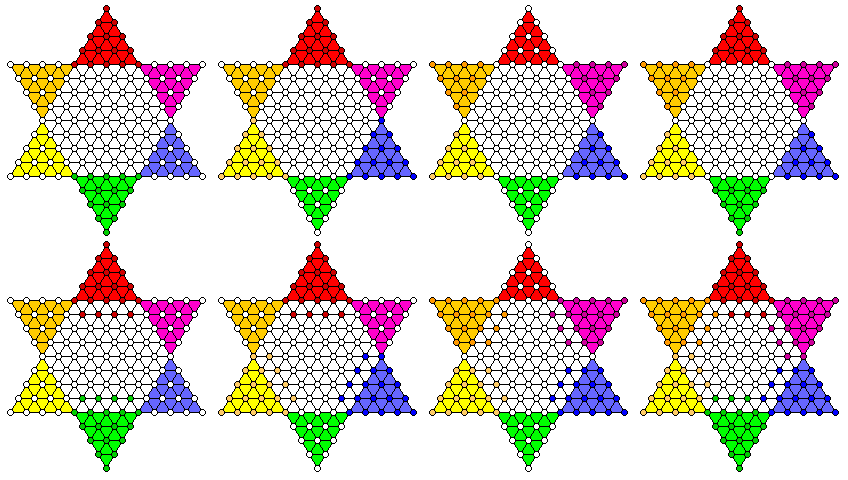
This page is concerned with a proprietary board game that is not currently offered for sale.
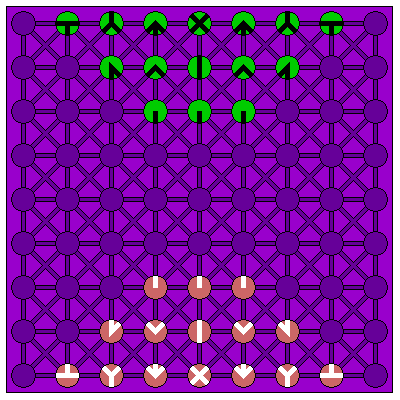
It is not primarily concerned with the game of Ploy, which was one of the Bookshelf Games offered by 3M at one time, although that is very definitely also a proprietary board game that is deserving of wider attention, some of which it received when it was recently reissued as Imperium by Schmidt Spiele.
Thus, I will note that the three pieces in the front move one space at a time, and are called Shields; those in the next row move two spaces at a time, and are called Lances, those in the final row, except for the one in the middle, move three spaces at a time, and are called Probes. The central piece moves one space at a time, and is called a Commander. The object of the game is to capture the opponent's Commander, or all the pieces of the opponent except for the Commander. Pieces may either be moved from one space to as many spaces as they are allowed in one of the directions in which they point, or they may be rotated, as a move. The Shields, only, may also be first moved, and then rotated, as a single move.
Nor is it concerned about Reversi, which is again popular and widely played, after a version of it was brought out commercially under another trademark, although I will now mention a few words about it here.
The game was originally played on a board of a different shape, and was available to the public in that form in 1876, as invented by John W. Mollett, under the name "The Game of Annexation". I have seen the shape of the board for that game in three diagrams people have drawn for their web sites, but I have not been able to locate a more original source for that information:
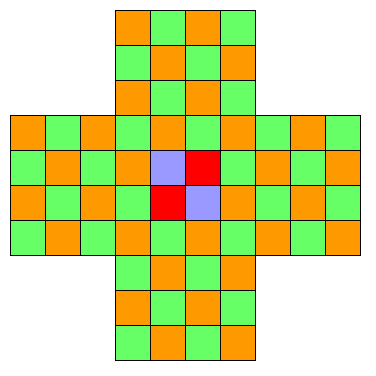
No doubt the board was printed in black-and-white, but it could well have been chequered in some way, as would have been common at that time.
Although I have not been able to find a contemporary account of the shape of its board, the legal case brought by John W. Mollett against Lewis Waterman is recorded in contemporary accounts (such as "The Law Times Reports of Cases Decided in the House of Lords, the Privy Council, the Court of Appeal..." volume LIX, for September 1888 to February 1889, available on Google Books), and so there is no doubt about the original provenance of the game.
However, the firm of F. H. Ayres, still billing Mollett as the inventor, later sold sets for the game of Annexation that used the same 8 by 8 layout as those sold by Lewis Waterman's firm Jaques & Co., which we will meet again on this page as selling Shan Tu, a variation of Chinese Checkers, and which is well known as having first sold Chess pieces on the Staunton pattern.
The modern game, played on a board with the same shape as a Chess or Checkers board, was invented in 1883 by Lewis Waterman. However, it still differed in two respects from the game currently sold as Othello, invented by Goro Hasegawa: in Reversi, players begin by alternately placing pieces in the four central squares of the board, rather than automatically starting from the fixed configuration which is the recommended one for Reversi, and, in Reversi, if a player cannot place a piece so as to flip some of the opponent's pieces in a turn, that player merely forfeits his turn, not the game.
Although Othello began being sold commercially in 1973, Goro Hasegawa invented this version of Reversi shortly after the end of the Second World War; this was before the game of Reversi was brought to public awareness in Martin Gardner's Mathematical Games column for July, 1961, so it indeed was an independent invention.
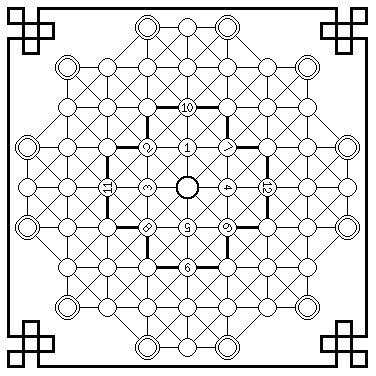
Later, a more elaborate version of Reversi was brought out, where the pieces were cubes having six different colors on their six sides, so that it could be played by up to six players, under the name "Royal Reversi", the board being pictured at left.
In this version of the game, one piece is rolled as a die to decide who the first player will be, and then it is placed with the same side uppermost on the central circle. Then, the players, starting with that first player and proceeding counter-clockwise, place pieces with their color uppermost on the numbered circles until each has placed two pieces, in the order indicated by the numbers:
10
2 1 7
11 3 -- 4 12
8 5 6
9
There was one very important way in which the rules for Royal Reversi differed from those for ordinary Reversi. In order to move, a player must be able to place a piece with his color uppermost so that there is a line of pieces of other colors, terminated by another piece with his color uppermost, to be flipped - or, in this case, rotated, to be his color. This is still true; what differs is that if such a move creates several such lines of pieces that can be turned, it is only required that the player making the move flip the pieces in at least one of those lines; flipping the pieces in any other line formed by the move is optional (although one can only flip all the pieces in a line, or leave them all untouched).
The 1947 edition of Richard L. Frey's The New Complete Hoyle notes that Royal Reversi was revived by Milton-Bradley in 1938 under the name Chameleon; this was later noted in Martin Gardner's column as well. However, Martin Gardner correctly noted that Chameleon was not quite identical to Royal Reversi: in fact, its board looked like this:

Although the central squares are numbered, somewhat as in Royal Reversi, the square in the center is not skipped, but is instead square number 7, the numbers running from 1 to 13, so the rules for the initial placement of the first few pieces would have to be at least slightly different from those for Royal Reversi to accommodate this, such as placing the first piece on square 7, and then the others in numerical order skipping number 7.
The board, instead of simply being a flat printed surface, had square holes in which the cubes rested.
There is also a game, published by Dujardin, named "Royal Reversi", which uses disks that have two different colors on their two sides, as in Reversi or Othello, and which come in several different pairs of colors; these disks are placed on an 8 by 8 board on which the squares bear images of playing cards.
In 1863, George Safford Parker was born. He went on to great fame as the founder of the Parker Pen company.
When he was three or four years old, however, he was not yet famous. And thus it was that in 1867, George Swinnerton Parker was born, who was also famous as the founder of the firm of Parker Brothers. This firm is well known as being the North American licensee for the British game Cluedo, sold as Clue in the U.S. and Canada, and for several of its own games, for example, the card game Pit, invented by one Edgar Cayce, not unknown to fame in another connection. It may not be as well known that Mah Jongg, Tiddly-Winks, and Ping Pong were also originally Parker Brothers trademarks. And, of course, it is even better known for a game of which virtually everyone who might see this web page has heard: Monopoly (which I now also discuss on this web site, on this web page).
This page concerns itself with another game, one invented by George S. Parker himself the year before he founded Parker Brothers, although it was not made available through Parker Brothers until some years later, in 1888.
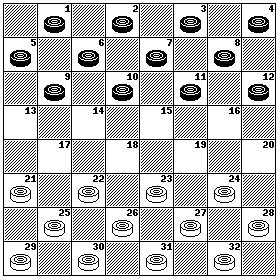
We are all familiar with the game of Checkers. In Checkers, a piece can move one space diagonally forwards, or it can jump over an opposing piece, again diagonally forwards, capturing it.
The object is to capture all of one's opponent's men, or make it impossible for the opponent to move.
And then there is the game of Chinese Checkers, in which a piece can jump over one's own, or one's opponents', pieces, without that resulting in a capture. The object is to place all of one's pieces in the starting area opposite to one's own starting area.

The diagram above shows, in the top row, the starting arrangements for Chinese Checkers applicable for two, three, four, or six players.
In the bottom row, the starting arrangements for Star Halma, the version of this game played in Continental Europe are shown as they would be for two, three, four, or six players. The arrangement for Star Halma for four players is merely assumed, and in fact that game may not be playable by four players, if, as I think reasonable, in the game for six players, the goal of Green, for instance, is to place his pieces not into Red's starting array, but rather into a mirror-reflection of Red's starting array including two points belonging to Orange's starting array. In that case, in the four-player game, the goals of the two players on one side of the board would overlap.
One might think of combining Checkers and Chinese Checkers to produce a game in which the pieces of one side could move one space, jump over the pieces of an opponent to capture those pieces, or jump over other pieces on its own side simply to move more quickly. As captures are possible, the object might be to move a small number of pieces into a few goal squares.
As it happens, George S. Parker showed outstanding originality by devising just such a game - years before Chinese Checkers was invented. Chinese Checkers was derived from an earlier game played on a conventional square board, Halma; this game originated in the United States in 1883 or 1884, however, while George S. Parker invented Chivalry in 1882. Halma is claimed to have been inspired by an English game named Hoppity which existed previously, but that game appears not to have been well known, as its rules apparently do not survive.
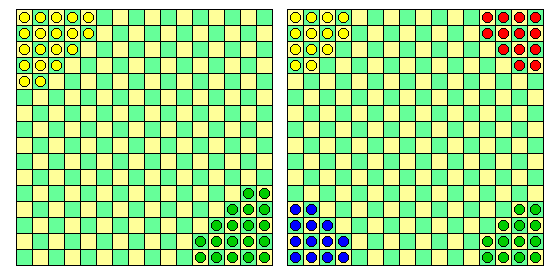
The diagram above shows the starting arrangements for Halma with two or four players. Incidentally, as noted in the rules for Peg Chow and Telka, it was also Parker Brothers that sold Halma.
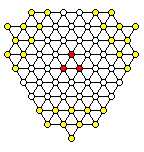
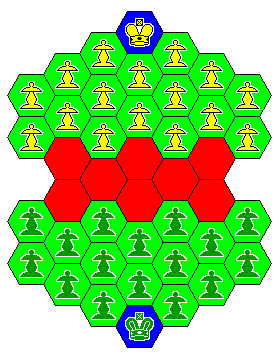
Chinese Checkers was popular enough to have encouraged other variations. The game pictured at left, Shan Tu, was published by Jaques, the company that later became famous as a maker of quality Chess pieces, particularly as it was the company that originally produced the Staunton pattern of piece. This was also the company that was owned by Lewis Waterman which originally sold Reversi.
Another old game of theirs, Hexagony, not the same as the later game of the same name by Avalon Hill, is pictured at right.
The rules of Jaques' Hexagony are not given on the Web, although they may survive somewhere. In the meantime, I will hazard a guess as to what they may have been.
I suspect that the pieces moved and captured like pieces in Checkers, except in the (orthogonal-like) directions of immediately adjacent hexagons, although they may not have been able to perform multiple jumps. The object of the game could have been to place one's own King in the starting square of the opponent's King; if so, two other rules are possible: the King might have been immune to capture by enemy Pawns (and possibly unable to capture them as well), but able to capture the opposing King by displacement if it is sitting on its starting square.
A more common rule for early games would be one requiring the King to move out of its starting square as soon as possible, but this is complicated by this not being possible at the start of the game.
The Pawns may also have been restricted from moving backwards to some extent.
Incidentally, I recently came across a picture of the board for Nona, described as a variant of Halma, invented by the Reverend J. H. Matthews, M. A., which was offered by F. H. Ayres, the rivals of Jaques & Co., at least in the case of Reversi, as we've seen above:
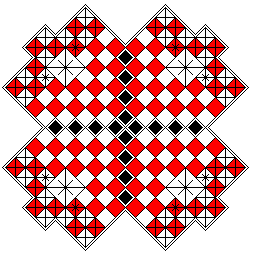
One could presume that it has the same rules as Halma (possibly with moves being orthogonal only or, for that matter, diagonal only) and with the cross-hatched squares indicating the starting positions of the men of four sides.
The black squares could be so colored for decorative purposes only, and the double-sized squares could be obstacles.
The fact that there are two squares behind the last row, in a row of their own, though, invites speculation that capturing jumps might have been possible, with the player only needing to get two pieces across to those two squares of the opposite opponent to win. If so, that game would have belonged to the same group as those which we are now about to consider. (One could even put Knights instead of Men on the two squares with the extra lines on them, thus making the board an alternate board for the game of Chivalry!)
The game that is the ostensible topic of this page is Chivalry, which became available to the public in 1888 (some sources give 1887). It was also during 1888 that George S. Parker and Company became Parker Brothers, and the packaging for Chivalry was prepared before that happened. Chivalry continued to be available until at least 1894.

In 1930, a modified version of the game, with somewhat fewer pieces and a slightly smaller board, was offered by Parker Brothers under the name Camelot, and it continued to be sold by Parker Brothers until 1968. An advertisement for this game, which appeared in the year of its introduction, is shown at left.
In 1985, the game of Camelot was brought back under a new name, Inside Moves, with changed styling, but it was discontinued the next year. For some context, it was in 1952 that George S. Parker passed away.
A four-player version, Grand Camelot, was brought out in 1932, and a smaller version of the game, Cam, was brought out in 1949.
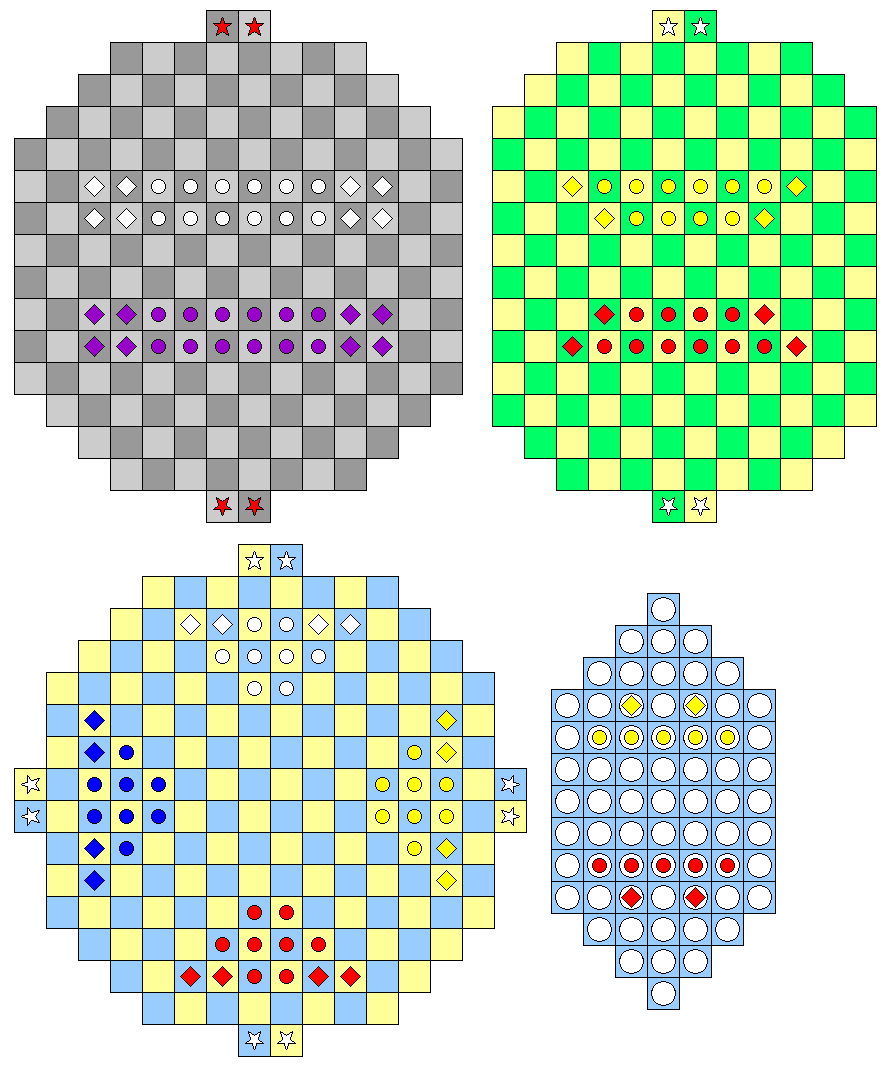
The image above illustrates the board and initial layout for Chivalry, Camelot, Grand Camelot, and Cam; in the top row, from left to right, Chivalry and Camelot; inthe bottom row, from left to right, Grand Camelot and Cam.
The pieces represented by circles are ordinary Men, and those represented by diamonds are Knights.
In 1931, sets for the game of Camelot included the rules for a variant of the game called Royal Camelot. In this variant, each side had one additional piece of a third kind, the King, which was placed immediately behind the existing men in the array in either one of the two most central squares.
The King had the following moves:
In Royal Camelot, when one player's King is captured, that player must then Ransom the King by surrendering one Knight and one Man to the other player, or by surrendering two Knights if no Men are available. Then, the King is to be placed anywhere on the board, except for the limitation that the King can't be placed on a square from which it may Jump or make a Knight's Charge; also, the pieces surrendered for a Ransom can't be ones the removal of which allows other pieces to make additional capturing moves.
As the rules for Royal Camelot were only included in Camelot sets for a brief period of time, the existence of this variant was forgotten until an old set containing them was discovered in 2020!
Also added to the rules included with a Camelot set in 1931, but left in them thereafter, so that they were well-known, were the rules for Point Camelot. The play of the game, and the conditions for winning, were the same, but in addition, points were scored as follows:
A series of games is played until an agreed-upon number of points is reached by one player; values of 1000 and 2000 are suggested. This variation helps to ensure there is a definite winner in a series of games.
At this point, it is also appropriate to mention the lost Camelot variant Camelotta. This was to have been a modification of Grand Camelot, for which rules would also be included in each Grand Camelot set; but while a notice to dealers in Parker Brothers games advised them this was coming, no set of rules for Camelotta is known to exist, and it is unknown if any were actually produced and sold. This notice described it as a partnership game, so presumably it was also for four players, as was Grand Camelot, and it also stated that the moves of the pieces were the same. Presumably, it required no additional equipment over that provided for Grand Camelot.
One guess as to what it might have been that occurred to me is that it might have taken the point system from Point Camelot, or a similar one, and combined it with some sort of auction phase before play, where the player who promises to win by the most points gets the first move, thus drawing inspiration from Auction Bridge, a very popular four-player partnership game of the times. However, I don't really see that as too likely, because just the first turn, as opposed to naming the trump suit in Bridge, is not really enough of an advantage to sustain an auction mechanism.
The rules given for Chivalry in Great Board Games by Brian Love refer to the two sides as Red and Yellow, with Red moving first, as in Camelot. However, some photographs of pieces from surviving Chivalry sets show pieces that are Purple and White in color, although others show Red and Yellow pieces as well. Chivalry was available in editions at several different levels of price and quality; this may partially account for this, but purple and white pieces are known for two different categories of set.
Here is a picture of the Chivalry board and pieces from an old advertisement:
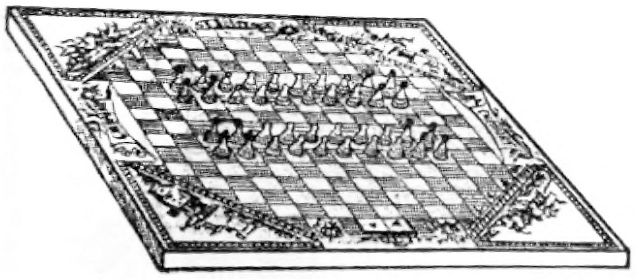
And, from a somewhat later advertisement, here is a picture of the Camelot board and pieces:
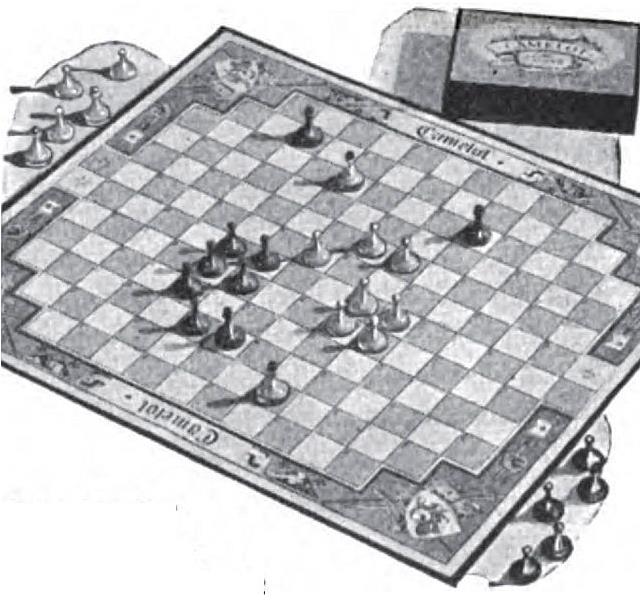
This diagram
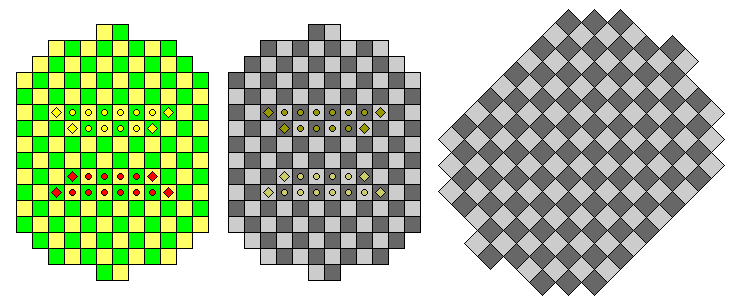
depicts the board for Camelot on the left, and the board for Inside Moves in the center. However, the layout for Inside Moves was rotated by 45 degrees, so that it could fit more efficiently on a square board, as shown on the right.
Note that the darker and lighter squares are switched, marking a return to the same color scheme as that of Chivalry.
The game of Inside Moves was advertised with the slogan: "The Strategy Game No Two People Play the Same".
The different moves were renamed for Inside Moves:
Chivalry Inside Moves Camelot Canter Jump Jump Capture Knight's Charge Power Play
And, as well, the Knight was renamed the Power Piece. This renaming was so confusing, "Jump" now being used as the name of a different move, that it actually ended up leading to at least one error in the rules sheet for the game. In addition to that, the review of the game by R. Wayne Schmittberger in the August, 1985 issue of GAMES magazine notes that the rule that capture is compulsory, but only when achievable by a Capture (Jump) only, but not when it requires a Power Play (Knight's Charge) is not explicitly given in the rules as provided with the game of Inside Moves, but it can still be inferred from the description of an example game in the rules booklet!
Also, the pieces are wooden, with a metal ball at the top; the Power Piece (Knight) is taller, and its metal ball is of golden-colored brass, while the Pawn (Man) has a metal ball of a silvery color. The pieces of one side are of a light natural wood color, and those of the other side a dark brown, and the two sides are referred to as Light and Dark, rather than Red and Yellow.
Obviously, a heroic attempt to distance the game from its past as a board game for children that children weren't interested in, to give it a future as a modern, stylish game for adults... even though it was not met with success. The game itself may have deserved better, since, as an advertisement for Camelot said,
"Camelot fills the wide space which for some centuries has existed unfilled between Chess and Checkers, with a game far livelier and more interesting than Checkers, and vastly simpler and easier than Chess."
Here is a detail from the advertisement in which that was said, showing the remark:

and, indeed, the game truly does lie somewhere between Chess and Checkers, definitely simpler than Chess, and likely to be at least somewhat livelier and more interesting than Checkers. However, the demand for a game filling that gap may not have been strong enough to sustain a proprietary game; from such games, the public may expect somewhat more in the way of immediate gratification, hence the success of Monopoly. I discuss this issue at greater length below.
The basic rules are:
Just as the game of Checkers allows moves to be recorded by assigning a number to each black square, boards for the game of Camelot had numbers on the spaces as well. Although this was not the case for Chivalry, a numbering system was also used for both Grand Camelot and for Cam. I have not yet been able to recover all the details of these latter numbering systems, however, but that for Camelot is:
____ ____
| A| B|
____ ____ ____|____|____|____ ____ ____
| 1| 2| 3| 4| 5| 6| 7| 8|
____|____|____|____|____|____|____|____|____|____
| 9| 10| 11| 12| 13| 14| 15| 16| 17| 18|
____|____|____|____|____|____|____|____|____|____|____|____
| 19| 20| 21| 22| 23| 24| 25| 26| 27| 28| 29| 30|
|____|____|____|____|____|____|____|____|____|____|____|____|
| 31| 32| 33| 34| 35| 36| 37| 38| 39| 40| 41| 42|
|____|____|____|____|____|____|____|____|____|____|____|____|
| 43| 44| 45| 46| 47| 48| 49| 50| 51| 52| 53| 54|
|____|____|____|____|____|____|____|____|____|____|____|____|
| 55| 56| 57| 58| 59| 60| 61| 62| 63| 64| 65| 66|
|____|____|____|____|____|____|____|____|____|____|____|____|
| 67| 68| 69| 70| 71| 72| 73| 74| 75| 76| 77| 78|
|____|____|____|____|____|____|____|____|____|____|____|____|
| 79| 80| 81| 82| 83| 84| 85| 86| 87| 88| 89| 90|
|____|____|____|____|____|____|____|____|____|____|____|____|
| 91| 92| 93| 94| 95| 96| 97| 98| 99| 100| 101| 102|
|____|____|____|____|____|____|____|____|____|____|____|____|
| 103| 104| 105| 106| 107| 108| 109| 110| 111| 112| 113| 114|
|____|____|____|____|____|____|____|____|____|____|____|____|
| 115| 116| 117| 118| 119| 120| 121| 122| 123| 124| 125| 126|
|____|____|____|____|____|____|____|____|____|____|____|____|
| 127| 128| 129| 130| 131| 132| 133| 134| 135| 136| 137| 138|
|____|____|____|____|____|____|____|____|____|____|____|____|
| 139| 140| 141| 142| 143| 144| 145| 146| 147| 148|
|____|____|____|____|____|____|____|____|____|____|
| 149| 150| 151| 152| 153| 154| 155| 156|
|____|____|____|____|____|____|____|____|
| Y| Z|
|____|____|
Since both Chivalry and Camelot were published before 1978, Chivalry is no longer protected by copyright in the United States, and Camelot will fall out of copyright in 2025. But, of course, trademark protection is applicable indefinitely.
Additional information about these games is available on the BoardGameGeek site, on Wikipedia, and on the home page of the World Camelot Federation. It might be noted that the World Camelot Federation is encouraging the use of algebraic notation for Camelot and related games, one reason being that it is more compatible with the computer program Zillions of Games, but other reasons favor that as well.
I am indebted to Michael Nolan for the information allowing me to create this chart of the numbering scheme used for Grand Camelot, both from the material on his web site, and a communication establishing additional details not present there:
____ ____
| A| B|
____ ____ ____|____|____|____ ____ ____
| C| D| E| F| G| H| I| J|
____|____|____|____|____|____|____|____|____|____
| K| L| M| N| O| P| Q| R| S| T|
____|____|____|____|____|____|____|____|____|____|____|____
| 10| 20| 30| 40| 50| 60| 70| 80| 90| 100| 110| 120|
____|____|____|____|____|____|____|____|____|____|____|____|____|____
| 1| 11| 21| 31| 41| 51| 61| 71| 81| 91| 101| 111| 121| 131|
|____|____|____|____|____|____|____|____|____|____|____|____|____|____|
| 2| 12| 22| 32| 42| 52| 62| 72| 82| 92| 102| 112| 122| 132|
|____|____|____|____|____|____|____|____|____|____|____|____|____|____|
| 3| 13| 23| 33| 43| 53| 63| 73| 83| 93| 103| 113| 123| 133|
____|____|____|____|____|____|____|____|____|____|____|____|____|____|____|____
| U| 4| 14| 24| 34| 44| 54| 64| 74| 84| 94| 104| 114| 124| 134| W|
|____|____|____|____|____|____|____|____|____|____|____|____|____|____|____|____|
| V| 5| 15| 25| 35| 45| 55| 65| 75| 85| 95| 105| 115| 125| 135| X|
|____|____|____|____|____|____|____|____|____|____|____|____|____|____|____|____|
| 6| 16| 26| 36| 46| 56| 66| 76| 86| 96| 106| 116| 126| 136|
|____|____|____|____|____|____|____|____|____|____|____|____|____|____|
| 7| 17| 27| 37| 47| 57| 67| 77| 87| 97| 107| 117| 127| 137|
|____|____|____|____|____|____|____|____|____|____|____|____|____|____|
| 8| 18| 28| 38| 48| 58| 68| 78| 88| 98| 108| 118| 128| 138|
|____|____|____|____|____|____|____|____|____|____|____|____|____|____|
| 19| 29| 39| 49| 59| 69| 79| 89| 99| 109| 119| 129|
|____|____|____|____|____|____|____|____|____|____|____|____|
| AA| BB| CC| DD| EE| FF| GG| HH| II| JJ|
|____|____|____|____|____|____|____|____|____|____|
| KK| LL| MM| NN| OO| PP| QQ| RR|
|____|____|____|____|____|____|____|____|
| Y| Z|
|____|____|
Incidentally, finding White and Yellow pieces hard to distinguish, the World Camelot Federation has replaced the White pieces by Green pieces in its official rules for Grand Camelot, thus limiting the issue to the color-blind.
Halma and Chinese Checkers were discussed above. Parker Brothers brought out their own unique variation on Chinese Checkers, which they called Peg Chow, played on the board shown below:
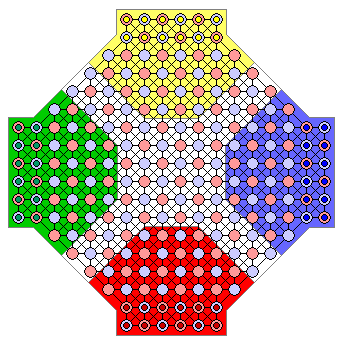
I had first seen this game in the book on woodworking projects for making board games "Games You Can Make and Play" by Paul V. Champion. Note that each side has twelve men, despite the colored areas on the board being larger in size than twelve spaces.
I discuss that game here, rather than above, because the game set included rules for a more challenging game, Telka, which was closely related to Chivalry and Camelot; here, the object of the game was to get three men, not all twelve, into the twelve starting spaces of the opponent opposite; and jumping over an opponent's piece in the white area of the board, the "Danger Zone", captures that man.
There is some evidence that the names Tekla and Peg Chow were only registered by Parker Brothers in the 1930s, but also that they did produce a game in 1891 that at least used the identical board. The earlier board was decorated with illustrations having a Classical theme instead of a Chinese one, suggesting that the name Peg Chow was not used then.
I have just recently located, in the October 22, 1891 number of The American Stationer, a reference to the name Telka having been used by Parker for a game at that time, and presumably it was the same game on the same board; the reference compares it to Chivalry, categorizing the latter as a more "scientific" game, but praising Telka for its interest. Also, Telka is advertised on the booklet for the "Amusing Reading Game" My Wife and I, also from Parker, dated 1888.
Despite this, though, U. S. Patent 2,187,808, granted on January 23, 1940, for which the application was filed on May 14, 1938, was for the game Telka rather than Peg Chow, because it specifically referenced the fact that pieces in the Danger Zone could be captured.
Subsequently, I encountered a thesis entitled "Amusements of Worcester School Children", by Thomas R. Croswell, which was published in the Pedagogical Seminary, volume VI, September 1899, referring to children in Worcester, Massachusetts, in which the game of Telka is listed among games mentioned by children surveyed on the amusements in which they engage. This, of course, adds little to the confirmation provided by the other early references noted above, except to indicate that Telka survived several years after 1891.
The image below:
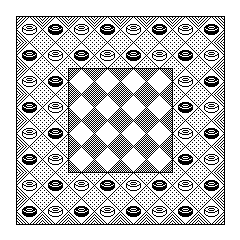
shows the board and initial layout for the game of King's Court, sold briefly by Golden Books, a division of the Western Publishing Company, during 1989. Another image, of the board rotated 45 degrees counterclockwise from its position in the diagram above, illustrates the color scheme used:
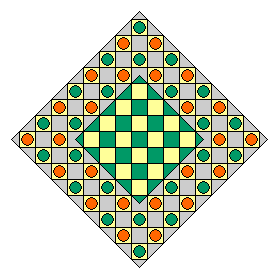
This game is also known as Supercheckers, and its inventor, Christopher Wroth, has regained the rights to the game, and has planned to publish it again himself.
The pieces move as does a crowned man in Checkers, but with the additional ability to jump over men of their own color without capturing them, and capturing is optional as in Chess or the older jeu plaisant form of Checkers. Pieces move only on the 64 light squares of the board. The game has a setup phase consisting of the first two moves, in which jumps are not allowed, where first one player moves one of his men into the central area, and then the other player moves one of his men into the central area from the opposite side of the board. After the setup phase, the first player to be eliminated from the central area of the board loses.
As pieces move only on the 64 light squares, it could be played on an ordinary checkerboard with the pieces moving and jumping orthogonally, of course, but the design of the board nicely reflects the fact that in Checkers, pieces move diagonally.
One other game in which the object was to move one's pieces to the starting squares of the opponent, but in addition captures were possible, was played by the Zuni Indians. It was called the Game of the Stone Warriors, or Awithlaknakwe; it is less well-known than another game they played, the game of Kolowis Awithlaknannai, or Fighting Serpents.
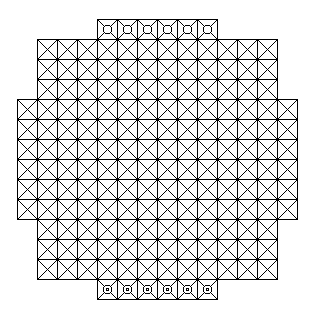
In this game, all the pieces moved diagonally forwards, as in Checkers. Capture was custodian capture along diagonal lines.
The first capture made by each side resulted in a piece becoming available which was called the Priest of the Bow, and which could move one space orthogonally as well as diagonally.
The account I have does not give a complete set of rules. Apparently, the special piece is received by the side that had a piece captured, not the side making the capture, which seems odd by our standards, but if the special piece needs to be re-entered on one of the six starting spaces, instead of replacing the captured piece on its own square, the additional orthogonal move is a small compensation for the loss of advancement.
Also, if a player's obligation is always to get all his remaining pieces to his opponent's back rank, is there some minimum number of pieces greater than one that a player must have to be able to win, since having fewer pieces to advance would seem to make winning easier?
But then, perhaps this game is not intended to be one of all-out competition. Or, perhaps captured pieces must be re-entered on the starting row? In that case, the fact that while each square is crossed by diagonal lines, but the squares are not chequered, makes it easier for a careless player to re-enter a piece on a square which would be of the wrong color on a chequered board, making winning impossible.
The orthogonal move of the Priest of the Bow not only deals with that problem in its case, but makes this left-behind and isolated piece more adroit in avoiding capture; it could be usual to resign after a second capture in any case.
The account of it in Stewart Culin's Games of the North American Indians stems from a report of the game made in 1893.
Giving the matter some thought, I've come up with some additional rules to add to the game which would make it into something people could play for fun.
If a piece, other than the Priest of the Bow, is moved to one of the outside two squares on either side of the board in the last row before the back rank of six spaces, so that it can no longer move forward, yet has not reached the last row of six spaces, it is removed from the board, and counted as if it was captured.
The game is over when one player has moved all of his pieces, however many or few they may be, to the far row of six spaces from which the opponent's pieces started.
At the end of the game, each player counts the number of pieces he has captured, and the number of pieces he has advanced to the final row. The player with the largest total wins; if the two counts are equal, the player who ended the game by moving all his remaining pieces to the back row is the winner.
At some time prior to 1985, I had heard of the game Chivalry from the book Great Board Games by Brian Love, as well as from reproductions of old mail-order catalogues which showed the games of a bygone era; I remember being struck by the fact that the game best known as Parcheesi was sold under the name of ChessIndia.
Thus it was that when I saw the game Inside Moves appearing in stores, I recognized it as a re-introduced, but shrunken, version of Chivalry. Although Camelot had remained available until 1968 from Parker Brothers, and I remember at least one time I visited the local Eaton's department store and purchased The Black Cat Fortune Telling Game, another Parker Brothers game with a long vintage, I was completely unaware that it had ever existed until very recently, and it was only thanks to the Internet that I learned of it.
Both Chivalry and Camelot received glowing testimonials from experts in the games of Checkers, Bridge, and Chess, including J. R. Capablanca and F. J. Marshall in the latter case.
Despite being the brainchild of George S. Parker, and therefore having the resources of Parker Brothers behind it, and being a game of apparent merit, widespread recognition and popularity appears to have eluded Chivalry and its derivatives.
Before asking why this might be, it should be noted that this is true of many other games of strategy of merit. There was Ploy, mentioned above. There were Scarney and Teeko. And, for that matter, there was Capablanca Chess, and there is also the Hexagonal Chess of Wladyslaw Glinski.
If one seeks a challenging game of skill to play, there are many traditional choices with an extensive literature behind them; Chess, and also Chinese Chess and Shogi; Checkers, and its Continental version; and even Go.
People seeking lighter entertainment from a board game have traditional choices as well, such as Snakes and Ladders, Chinese Checkers, or Backgammon, for example, but in that area there is nothing comparable to either Monopoly or The Game of Life, for example. Thus, when it comes to a proprietary board game, what people tend to be expecting and looking for is something that is exciting and entertaining, and elaborate and colorful.
In addition to this, the investment in learning to play a game well, if that game is nonproprietary, traditional, and well-recognized may be considered as a more worthwhile investment, as it provides a skill that might be more valuable, because it would be more likely to be recognized as impressive, and it would be useful on more occasions.
A very few proprietary games of skill have succeeded in obtaining enduring popularity. The game Othello was one success, but in that case, success was partly due to its bringing about a revival of Reversi. Another success was the game of Master Mind, which Parker Brothers and now Hasbro sell in North America.
The fact that capture is compulsory in Camelot, as in Checkers, somewhat mitigates against it, in my opinion. Having Checkers as a basis is common for games of that period, with Siege of Paris and The Strand War Game as other examples, however. The reason I say this is partly that some temperaments tend to resent the compulsion to move in a certain way, but also that, as current experience with enabling computers to play games confirms, a compulsory capture rule adds challenge to a game in the form of calculation, while games of skill that rely more on pattern recognition are relying on a less fatiguing human ability.
That being said, compulsory capture is essential to the game of Camelot for two reasons. One is that since the goal of the game is to move two of one's pieces to designated goal squares, a means is needed to counteract a strategy of blockade. The second is that it adds to the distinctiveness of the Knight, which, in the Knight's Charge, has an optional capturing move.
Of course, neither Smess nor its later version All the King's Men succeeded for Parker Brothers either, despite not having this particular feature. However, the fact that the moves of the pieces were indicated by arrows on the board, intended to make the games easier to learn, may also have tended to replace pattern recognition by calculation, for that matter.
Parker Brothers was also responsible for another game which could be considered to be a simplified Chess variant:
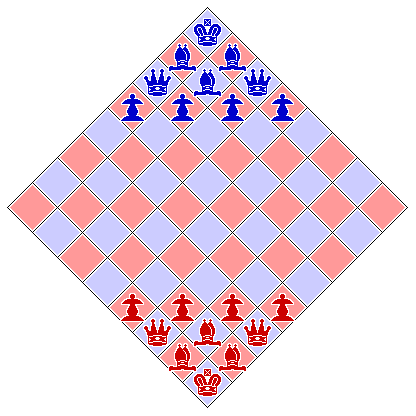
The game of Citadel was played with four types of pieces. The Citadel, shown as a King, the Herald, shown as a Bishop, and the Baron, shown as a Queen, all moved as did their corresponding Chess pieces. Capturing the Citadel wins the game, so stalemating the opponent is a way to win. The Archer is shown as a Pawn; however, its move is different from a Pawn's move. The Archer moves and captures by moving one step orthogonally. In addition, it can move, but not capture, by jumping over a friendly piece to the square beyond; this two-space move can only be made in an orthogonal direction as well. Also, unlike a Pawn, it does not promote, and it is not limited to forwards moves only
Note that the orthogonal move of the Archer, and the diagonal move of the Herald, are relative to the board itself when considered as a conventional Chess board, not to its orientation; thus, the Herald moves to squares of the same color in moving diagonally, although with the board as it is oriented, those are moves up, down, left, and right. In the rules that came with the game, due to the confusion that the terms "orthogonal" and "diagonal" would tend to cause, moves that are through the corners of the squares are referred to as moves along "Diamond Channels", and moved that are through the sides of the squares are referred to as moves along "Square Channels".
Thus, the moves I have called "orthogonal", even though they are in diagonal directions, because the board is rotated, are "Square Channel" moves, and the moves I have called "diagonal", even though they are in orthogonal directions, are "Diamond Channel" moves.
Because of the similarity between Chivalry and Checkers, it seems appropriate to discuss another interesting game on this page which was based on Checkers, although it does not include the additional possibility of jumping over one's own men without capturing them.
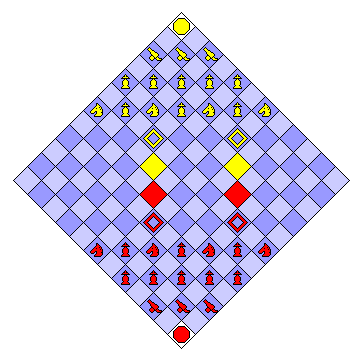
The illustration above shows the board and initial layout for the Strand War Game.
This game was devised for the Strand Magazine, most famous as the original publisher of the Sherlock Holmes mysteries, during the First World War, then known as the Great War.
The rules are:
Clue, Pit, Monopoly, Chivalry, Camelot, Grand Camelot, Cam, Inside Moves, Citadel, Smess, All the King's Men, Peg Chow, Telka, Hexagony, and The Black Cat Fortune Telling Game are, of course, trademarks of Hasbro, the firm which currently owns Parker Brothers, The Game of Life is a trademark of Hasbro, as it is also the firm that owns Milton Bradley, King's Court is a trademark of Hasbro, not only as it is the firm that owns the boardgame operations of the Western Publishing Company, but also because it published a card game by that name a few years earlier, Parcheesi is a trademark of Hasbro, as it purchased Coleco which purchased Selchow and Righter, Hexagony is a trademark of Hasbro, as it purchased Strategic Publications International which purchased Avalon Hill, and Cluedo is a trademark of Waddington's, and Ploy is a trademark of 3M, formerly also known as the Minnesota Mining and Manufacturing Company. Imperium is a trademark of Schmidt Spiele. and Teeko and Scarney are trademarks of John Scarne Games, Incorporated. Othello is a trademark of Tsukuda Original. Master Mind is a trademark of Invicta Plastics.